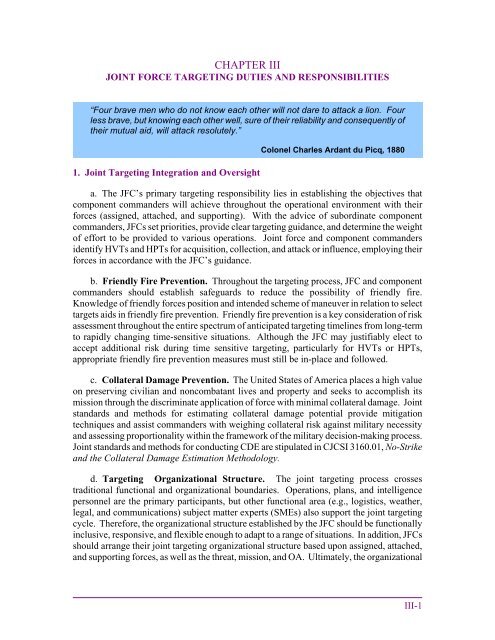Joint Targeting
1F87id9
1F87id9
Create successful ePaper yourself
Turn your PDF publications into a flip-book with our unique Google optimized e-Paper software.
CHAPTER III<br />
JOINT FORCE TARGETING DUTIES AND RESPONSIBILITIES<br />
“Four brave men who do not know each other will not dare to attack a lion. Four<br />
less brave, but knowing each other well, sure of their reliability and consequently of<br />
their mutual aid, will attack resolutely.”<br />
1. <strong>Joint</strong> <strong>Targeting</strong> Integration and Oversight<br />
Colonel Charles Ardant du Picq, 1880<br />
a. The JFC’s primary targeting responsibility lies in establishing the objectives that<br />
component commanders will achieve throughout the operational environment with their<br />
forces (assigned, attached, and supporting). With the advice of subordinate component<br />
commanders, JFCs set priorities, provide clear targeting guidance, and determine the weight<br />
of effort to be provided to various operations. <strong>Joint</strong> force and component commanders<br />
identify HVTs and HPTs for acquisition, collection, and attack or influence, employing their<br />
forces in accordance with the JFC’s guidance.<br />
b. Friendly Fire Prevention. Throughout the targeting process, JFC and component<br />
commanders should establish safeguards to reduce the possibility of friendly fire.<br />
Knowledge of friendly forces position and intended scheme of maneuver in relation to select<br />
targets aids in friendly fire prevention. Friendly fire prevention is a key consideration of risk<br />
assessment throughout the entire spectrum of anticipated targeting timelines from long-term<br />
to rapidly changing time-sensitive situations. Although the JFC may justifiably elect to<br />
accept additional risk during time sensitive targeting, particularly for HVTs or HPTs,<br />
appropriate friendly fire prevention measures must still be in-place and followed.<br />
c. Collateral Damage Prevention. The United States of America places a high value<br />
on preserving civilian and noncombatant lives and property and seeks to accomplish its<br />
mission through the discriminate application of force with minimal collateral damage. <strong>Joint</strong><br />
standards and methods for estimating collateral damage potential provide mitigation<br />
techniques and assist commanders with weighing collateral risk against military necessity<br />
and assessing proportionality within the framework of the military decision-making process.<br />
<strong>Joint</strong> standards and methods for conducting CDE are stipulated in CJCSI 3160.01, No-Strike<br />
and the Collateral Damage Estimation Methodology.<br />
d. <strong>Targeting</strong> Organizational Structure. The joint targeting process crosses<br />
traditional functional and organizational boundaries. Operations, plans, and intelligence<br />
personnel are the primary participants, but other functional area (e.g., logistics, weather,<br />
legal, and communications) subject matter experts (SMEs) also support the joint targeting<br />
cycle. Therefore, the organizational structure established by the JFC should be functionally<br />
inclusive, responsive, and flexible enough to adapt to a range of situations. In addition, JFCs<br />
should arrange their joint targeting organizational structure based upon assigned, attached,<br />
and supporting forces, as well as the threat, mission, and OA. Ultimately, the organizational<br />
III-1


